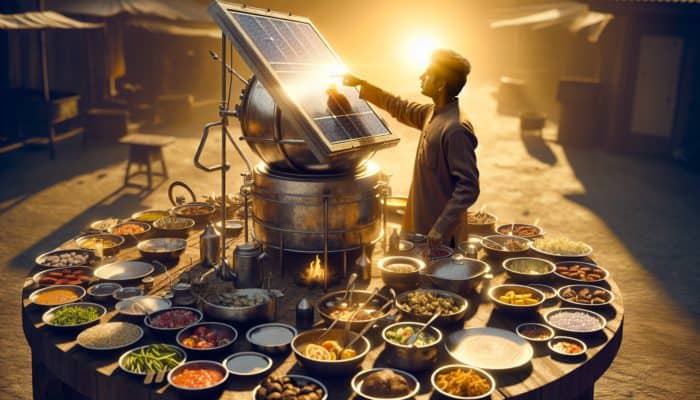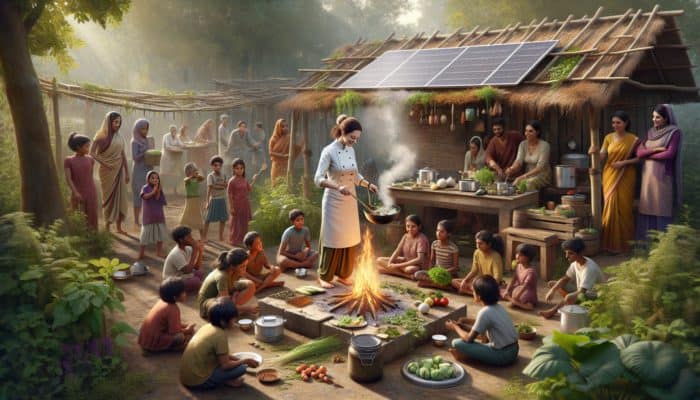Discover the Art of Cooking Without Electricity: Your Ultimate Resource
What Does Cooking Without Electricity Entail?

Cooking without electricity encapsulates a fascinating culinary practice that emphasises meal preparation through methods that entirely forego electric or gas-powered devices. This approach, rooted in ancient techniques respected across numerous cultures for generations, encourages innovation and ingenuity within the kitchen. By immersing oneself in this form of cooking, individuals can discover practical and inventive methods that are not only environmentally conscious but also sustainable. Prominent techniques for cooking without electricity include:
- solar cooking
- open fire cooking
- Haybox cooking
- Pit cooking
- Thermal mass cooking
- Utilising a rocket stove
- Food preservation through fermentation and drying
Engaging with these varied techniques not only sharpens one's culinary skills but also nurtures a profound appreciation for the rich cultural heritage inherent in these traditional practices.
Uncover the Diverse Advantages of Cooking Without Electricity
Embarking on the journey of cooking without electricity reveals a multitude of benefits that extend well beyond mere meal preparation. This approach primarily champions sustainability, significantly diminishing reliance on fossil fuels and electricity, collectively leading to a marked reduction in one's carbon footprint. Additionally, cooking without electricity is often more cost-effective, as it leverages readily available resources instead of relying on costly energy sources. Furthermore, this cooking style cultivates a deeper connection with food, as individuals dedicate time and effort to the creation of their meals. Here are some key benefits linked with cooking without electricity:
- Cost savings on utility bills
- Enhanced food security through improved self-sufficiency
- Environmental sustainability resulting from reduced carbon emissions
- Improved health through a focus on fresh ingredients
- Strengthened community ties through shared culinary experiences
- Encouragement of culinary creativity and experimentation
By wholeheartedly embracing these practices, individuals can transform their cooking experiences into rewarding and enriching endeavours that resonate with their core values.
Key Equipment for Mastering Cooking Without Electricity
Equipping oneself with the right tools is essential for effectively mastering the art of cooking without electricity. A variety of indispensable tools can streamline the meal preparation process, enabling a seamless transition from conventional cooking methods. Solar cookers efficiently harness the sun's energy, while fire pits create a nostalgic outdoor cooking experience. Manual food processors and blenders allow for ingredient preparation without the need for electric power. Here’s a comprehensive list of essential tools you will require for cooking without electricity:
- Solar cookers
- Fire pits or grills
- Rocket stoves
- Hayboxes or insulated cookers
- Portable charcoal grills
- Manual food processors
- Cast iron cookware
- Fermentation vessels
These tools empower cooks to explore a wide range of culinary possibilities while maintaining a commitment to sustainable cooking practices.
Creative Techniques for Culinary Mastery Without Electricity

A diverse array of techniques exists for cooking without electricity, each offering unique benefits and applications across different environments and culinary traditions. Solar cooking utilises the sun’s energy—an abundant renewable resource—for meal preparation. This method necessitates specific equipment designed to effectively capture and retain solar heat. Best practices for solar cooking involve positioning the solar cooker directly towards the sun and utilising dark-coloured pots, which significantly enhance heat absorption for optimal cooking outcomes.
Methods of open fire cooking, such as grilling and roasting, offer an authentic culinary experience often associated with social gatherings and celebrations. Safety is crucial when cooking over an open flame; thus, ensuring adequate ventilation, managing firewood properly, and having a nearby water source for emergencies are critical precautions to follow.
Thermal mass cooking employs retained heat for slow and even cooking, utilising materials like bricks or stones to retain warmth. To achieve maximum efficiency with this method, preheating the thermal mass before placing food inside is essential, ensuring that optimal cooking conditions are met.
Ensuring Safety While Cooking Without Electricity
Safety considerations are paramount when cooking without electricity, as traditional cooking methods can introduce unique risks. Adequate ventilation is essential, particularly when cooking over open flames, to prevent the accumulation of harmful gases. Proper fire handling requires using appropriate tools while maintaining a safe distance from flammable materials. Following food safety guidelines is vital to avert spoilage and foodborne illnesses. Key safety considerations include:
- Maintaining proper food storage temperatures
- Using clean utensils and cookware
- Ensuring sufficient ventilation when using open flames
- Practising good hygiene during food preparation
By adhering to these safety measures, cooks can fully enjoy the numerous benefits of cooking without electricity while minimising potential risks.
Professional Insights on Cooking Without Electricity
What Knowledge Can Experts Share About Cooking Without Electricity?

Experts in sustainable living and culinary arts advocate for the practice of cooking without electricity, highlighting its numerous benefits for both individuals and the environment. Many culinary professionals stress the significance of selecting seasonal and locally sourced ingredients, which not only enhances flavour but also bolsters local economies. Real-world examples include chefs who conduct workshops aimed at imparting traditional cooking methods that do not rely on modern conveniences. They promote techniques like open-fire cooking, demonstrating ways to create delicious dishes while reducing dependence on electricity.
Moreover, sustainability advocates assert that cooking without electricity can encourage healthier eating habits. By steering clear of processed foods, individuals are more inclined to consume fresh, whole ingredients. Chefs frequently promote participation in community cooking events where participants can share knowledge and skills, fostering a deeper appreciation for food and its origins.
How Can Cooking Without Electricity Enhance Your Health?
Cooking without electricity can greatly improve health by promoting the use of fresh, unprocessed ingredients. This shift often results in meals that are nutrient-dense and free from artificial additives. Practical steps for adopting healthier cooking methods without electricity involve prioritising local and seasonal produce, which not only supports farmers but ensures the freshest ingredients are used. Embracing techniques like fermentation, which preserves nutrients, alongside methods such as solar cooking can further elevate meal quality.
Additionally, cooking without electricity cultivates mindfulness in food preparation. Engaging with food—such as chopping vegetables or stirring pots over an open flame—can transform into a meditative practice that enhances mental well-being. By focusing on the cooking process and being fully present, individuals can develop a healthier relationship with their food.
What Are the Environmental Advantages of Cooking Without Electricity?
The environmental impact of cooking without electricity is significant, as this approach can lead to substantial reductions in carbon footprints while promoting sustainable living practices. By foregoing traditional energy sources, individuals actively contribute to the decline of greenhouse gas emissions. Expert evaluations indicate that methods such as solar cooking and open-fire cooking leverage renewable energy sources, thereby minimising waste and environmental damage.
Furthermore, cooking without electricity encourages the use of local ingredients, which reduces the environmental costs linked to transporting food over long distances. By adopting sustainable cooking practices, individuals not only bolster their health but also play an active role in preserving the planet for future generations.
Advanced Strategies for Cooking Without Electricity
How to Optimize Solar Cooking for Maximum Efficiency?
Solar cooking employs the sun's energy to prepare meals, positioning it as an eco-friendly and sustainable alternative to conventional cooking methods. To optimise solar cooking, one must utilise specific equipment—such as solar cookers or solar ovens—designed to concentrate sunlight effectively. Effective practices for solar cooking include orienting the cooker to face the sun directly and adjusting its angle throughout the day, alongside using dark, heat-absorbent pots to enhance cooking efficiency.
Cooking times may vary depending on sunlight intensity, so a degree of patience is essential. Foods particularly suitable for solar cookers include rice, beans, and vegetables, which can be cooked in a single pot to minimise energy loss. Furthermore, experimenting with various recipes tailored for solar cooking can yield delightful results while promoting energy conservation.
Investigating Techniques for Open Fire Cooking
Techniques for open fire cooking, involving grilling or roasting over a campfire, are timeless practices that reconnect us with our culinary heritage. While incredibly rewarding, cooking over an open flame requires meticulous attention to safety. Essential safety precautions include selecting a designated fire pit area situated away from flammable materials and always having a water source nearby to extinguish the fire if necessary.
While preparing food, ensure that meats are thoroughly cooked to prevent foodborne illnesses, and utilise separate utensils for raw and cooked foods to avert cross-contamination. Exploring various cooking methods—such as skewering vegetables or meats on sticks or using cast iron pots over coals—can lead to unforgettable culinary experiences under the open sky.
Utilising Thermal Mass for Efficient Cooking
Thermal mass cooking represents an innovative approach that utilises retained heat for slow cooking, offering an efficient alternative to conventional cooking methods. This technique involves using materials such as bricks, stones, or specially designed thermal cookers that maintain heat for extended periods. To maximise the efficiency of thermal mass cooking, preheating the thermal mass before placing food inside is crucial to ensure a uniform and effective cooking process.
Foods particularly suited for this method include stews, soups, and grains, which benefit from the slow, even heat. Furthermore, this technique champions resourcefulness, often requiring minimal fuel and can be employed in various environments, from backyards to remote camping sites.
What Challenges Are Associated with Cooking Without Electricity?
How Can You Overcome Time Constraints When Cooking Without Electricity?
Cooking without electricity can occasionally present time constraints, particularly with methods like solar cooking that necessitate extended cooking durations. However, effective planning and preparation can alleviate these challenges. One strategy involves utilising quicker cooking methods for fast meals, such as open-fire cooking or preparing dishes that can be left to cook slowly while engaging in other activities.
Batch cooking represents another effective tactic, enabling the preparation of multiple meals simultaneously. By cooking larger quantities, individuals can save time during hectic weeks by simply reheating or enjoying leftovers. Additionally, employing techniques like haybox cooking—where food is placed in an insulated container after initial boiling—can substantially reduce cooking time while still yielding delicious, fully cooked meals.
Adapting Cooking Methods to Weather Variability
Weather conditions can significantly influence cooking without electricity methods, particularly solar cooking, which is heavily reliant on sunlight. However, adapting cooking techniques to varying weather conditions is entirely achievable. For instance, on overcast days, one can switch to open fire cooking or thermal mass cooking, both of which are less dependent on ideal weather conditions.
In inclement weather, consider indoor cooking options that utilise thermal mass materials or insulated pots. Additionally, planning meals according to local weather forecasts can optimise cooking times and methods, ensuring that meals are prepared efficiently, regardless of external conditions.
Effectively Managing Limited Resources in Cooking Without Electricity
Cooking without electricity often necessitates managing limited resources, such as fuel for open fire cooking or water for solar cooking. Developing effective resource management strategies is crucial. Prioritising efficiency by using minimal fuel sources, like small branches or twigs for an open fire, can extend cooking capabilities.
Moreover, embracing cooking methods that require fewer resources, such as haybox cooking, can prove beneficial. This method utilises insulation to retain heat without necessitating continuous fuel. Finally, preserving food through techniques like fermentation or drying can reduce the need for fresh ingredients, allowing cooks to optimise resources while minimising waste.
Ensuring Food Safety Without Traditional Power Sources
Maintaining food safety while cooking without electricity is critical, especially as conventional refrigeration methods may not be available. Proper storage and cooking techniques are essential to prevent spoilage and foodborne illnesses. First and foremost, ensure that all ingredients are fresh before use, particularly perishables like meats and dairy products.
Utilising cool storage methods, such as burying food in cool ground or employing insulated containers, can help maintain safe temperatures. Cooking food thoroughly, especially meats, is vital for eliminating harmful bacteria. Lastly, practising rigorous hygiene during food preparation, such as washing hands and utensils, can significantly minimise the risk of contamination.
Research-Backed Advantages of Cooking Without Electricity
What Do Studies Reveal About Nutritional Benefits?
Research indicates that cooking without electricity can preserve a greater number of nutrients in food compared to traditional cooking methods reliant on electricity or gas. Studies reveal that techniques such as solar cooking and steaming help retain vitamins and minerals that may be lost through conventional high-temperature cooking methods, such as boiling.
Moreover, cooking without electricity often emphasises the use of whole, unprocessed ingredients, contributing to higher nutritional quality in meals. Focusing on fresh produce encourages a diet rich in essential nutrients, leading to improved overall health. Consequently, individuals adopting these cooking methods are likely to see significant enhancements in their dietary habits and health outcomes.
How Does Cooking Without Electricity Influence Mental Well-being?
Cooking without electricity has the potential to positively impact mental health by promoting mindfulness and reducing dependence on technology. Engaging in the tactile experience of preparing meals—chopping, mixing, and cooking—can serve as a form of meditation, allowing individuals to disconnect from the digital world.
Actionable steps for improving mental well-being through cooking without electricity include establishing a routine that integrates cooking as a form of self-care. This could involve allocating time each week to experiment with new recipes, inviting friends or family to share in the cooking experience, or even attending classes to learn traditional cooking techniques. Such activities foster a sense of community and connection, further enhancing mental health.
How Does Cooking Without Electricity Promote Environmental Sustainability?
Cooking without electricity significantly contributes to environmental sustainability by reducing greenhouse gas emissions associated with traditional cooking methods. By harnessing renewable energy sources, such as solar or biomass, individuals can lessen their reliance on fossil fuels. Expert evaluations indicate that implementing these practices not only diminishes carbon footprints but also supports a sustainable lifestyle.
Additionally, cooking without electricity frequently encourages a lifestyle centred around local and seasonal ingredients, minimising the environmental costs associated with transporting food. This holistic approach enhances appreciation for the environment, as individuals become more mindful of their food sources and the impact of their choices on the planet.
How Can Cooking Without Electricity Strengthen Social Bonds?
Cooking without electricity can significantly bolster social connections by promoting communal cooking and shared meals. Traditional cooking methods often unite families and communities, fostering collaboration and bonding over shared culinary experiences.
One effective way to reinforce community ties is by organising potlucks or community cooking events, where individuals can exchange recipes and cooking techniques while enjoying each other’s company. Moreover, teaching friends or family members how to cook without electricity creates opportunities for shared experiences and learning, further deepening relationships through the joy of food preparation.
Integrating Cooking Without Electricity into Everyday Life
How to Seamlessly Incorporate Cooking Without Power into Your Daily Life?
Integrating cooking without electricity into daily life requires thoughtful planning and flexibility. Start by making small adjustments to your routine, such as dedicating one day a week to explore solar cooking or open-fire techniques. Gradually expanding this practice fosters a smoother transition, making it a more enjoyable experience.
Additionally, consider meal prepping for the week using cooking methods that don’t require power. For example, utilise haybox cooking for slow-cooked meals or prepare larger batches of food that can be easily reheated. Over time, these practices will become second nature, allowing cooking without electricity to become an integral part of your culinary lifestyle.
How to Introduce Children to the Joy of Cooking Without Electricity?
Teaching children to cook without electricity can instil invaluable life skills while promoting sustainability. This educational experience can be both engaging and enjoyable by making learning fun through hands-on activities and interactive cooking sessions.
Consider organising family cooking nights where children can assist in meal preparation using traditional methods like open-fire cooking or solar cooking. Encourage creativity by allowing them to choose ingredients and experiment with recipes, fostering a sense of ownership over their culinary creations. This approach not only builds essential skills but also deepens their appreciation for food and its origins.
Finding Balance Between Modern and Traditional Cooking Techniques
Striking a balance between modern and traditional cooking methods allows for flexibility and variety in meal preparation. Combining these approaches can optimise efficiency while still honouring culinary traditions. For instance, a modern slow cooker can be used alongside traditional methods like solar cooking, resulting in a diverse array of meal options.
The advantages of this balance include the opportunity to experiment with new techniques while still enjoying the comfort and familiarity of modern conveniences. This fusion can lead to innovative recipes that reflect both contemporary and traditional influences, celebrating the best aspects of both culinary worlds.
How to Address Challenges and Limitations of Cooking Without Power?
Addressing common challenges, such as time constraints and weather conditions, is crucial to making cooking without electricity more feasible and enjoyable. Effective planning and preparation can mitigate these obstacles. For instance, employing quicker cooking methods, like open-fire cooking, can save time when preparing meals.
Moreover, having backup plans for adverse weather conditions—such as maintaining alternative cooking methods—can ensure that meals are consistently prepared without electricity. Additionally, embracing resourcefulness and creativity in the kitchen can transform limitations into opportunities for culinary innovation, enriching the overall cooking experience.
Emerging Innovations in Cooking Without Electricity
What Are the Latest Advancements in Cooking Without Power Technology?
Innovations in cooking without electricity technology are continually emerging, introducing new and efficient ways to prepare meals. Recent advancements include solar cookers designed for enhanced efficiency, such as parabolic solar cookers that effectively concentrate sunlight, enabling faster cooking times.
Other innovations involve the development of portable biomass stoves that utilise waste materials, thereby reducing environmental impact while providing cooking solutions in off-grid settings. As technology continues to evolve, these new tools will further enhance the practicality of cooking without electricity, making it more accessible to a broader audience.
The Importance of Cooking Without Power in Sustainable Living
Cooking without electricity plays a vital role in sustainable living, promoting eco-friendly practices that diminish reliance on non-renewable energy sources. By embracing these methods, individuals contribute to a more sustainable lifestyle that minimises waste and prioritises local food sources.
Moreover, cooking without electricity fosters mindfulness in consumption, cultivating awareness of resource usage and food origins. This lifestyle choice benefits individuals and has a broader impact on the community and environment, contributing to a more sustainable future for all.
Cultural and Community Aspects of Cooking Without Electricity
Cooking without electricity nurtures cultural and community connections, often rooted in traditional methods and shared experiences. Celebrating these culinary practices helps preserve cultural heritage while advocating for sustainable living.
Community events focused on cooking without electricity can unite individuals, allowing them to share stories, recipes, and techniques. This collective experience not only strengthens community bonds but also keeps cultural traditions alive, enriching the culinary landscape for generations to come.
Frequently Asked Questions About Cooking Without Electricity
What Are the Most Effective Cooking Methods Without Electricity?
The most effective methods for cooking without electricity include solar cooking, open fire cooking, haybox cooking, and thermal mass techniques. Each method offers unique benefits, such as sustainability and efficiency.
How Can I Start Cooking Without Electricity?
Begin by incorporating small changes into your cooking routine, such as utilising a solar cooker on sunny days or experimenting with open fire cooking during camping trips. Gradually build your skills and confidence over time to enhance your culinary repertoire.
What Tools Are Essential for Cooking Without Electricity?
Essential tools for cooking without electricity encompass solar cookers, fire pits, rocket stoves, insulated hayboxes, and manual food processors. These tools facilitate various cooking techniques efficiently and effectively.
Is Cooking Without Electricity Safe for Food Preparation?
Yes, cooking without electricity can be safe if proper food safety practices are followed, including thorough cooking, maintaining hygiene, and ensuring appropriate food storage to prevent spoilage and contamination.
Can Cooking Without Electricity Result in Financial Savings?
Absolutely! Cooking without electricity can lead to significant savings on energy bills, as it decreases reliance on electricity and gas. Additionally, sourcing local ingredients can further reduce grocery expenses.
How Does Cooking Without Electricity Benefit the Environment?
Cooking without electricity aids in lowering carbon footprints by utilising renewable energy sources and minimising waste. It promotes sustainable practices that significantly benefit the planet and its ecosystems.
What Health Advantages Are Associated with Cooking Without Electricity?
Cooking without electricity often results in healthier meals, as it emphasises fresh ingredients and avoids processed foods. This dietary focus can lead to enhanced nutrition and improved overall health.
Can Children Learn Cooking Skills Without Electricity?
Yes! Teaching children to cook without electricity can impart valuable skills and foster a sense of sustainability. It can be an engaging and educational experience that nurtures creativity in the kitchen.
How Can I Maximise Efficiency When Cooking Without Electricity?
To maximise efficiency, plan your meals, utilise batch cooking techniques, and experiment with time-saving methods like haybox cooking or thermal mass cooking to minimise fuel consumption.
What Common Challenges Are Associated with Cooking Without Electricity?
Challenges include time constraints, weather dependencies, limited resources, and ensuring food safety. Nevertheless, effective planning and adaptability can help overcome these hurdles successfully.
Discover more on our journey at X!
The post Cooking Without Power: Essential Techniques and Tips appeared first on Survival Bite.
The Article Essential Techniques and Tips for Cooking Without Power Was Found On https://limitsofstrategy.com

